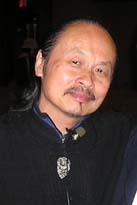n Monday, March 15, Lee Mung Wah presented a four-hour workshop based around his 1994 film The Color of Fear with members of the Guilford and greater Greensboro communities. Everyone wore a nametag labeled with their name and what they were most afraid of when talking about racism, so one could read everyone’s fears as clearly as reading their name.
“Fear of being angry.” “Fear of being bitter.” “Fear of sounding racist.” “Fear of having nothing to say.” With everyone’s fears emblazoned on their chests, the dialogue began before Wah took the stage.
Wah spoke softly, easing the audience’s tension at having found themselves so exposed. He also played on people’s expectations, joking that the seminar was going to be a place where “people of color … tell their stories, and white folks feel guilty.”
Through a series of simple exercises, Wah brought attention to the racial tension present in the room. He called for everyone who had ever been discriminated against for their skin color to stand, and then asked those who were still in their seats to ponder, “why are they standing, and why am I sitting?”
Then Wah addressed the crowd as a whole. “You’re all here for a lecture on diversity, and look who you’re sitting next to,” he said. The audience then laughed as they realized his point; blacks were sitting with blacks, and whites were sitting with whites.
Wah then instructed everyone to get out of their seats, and partner “with someone who doesn’t look like you.” When the shuffling stopped, the “color lines” had dissolved.
Ten minutes were allotted for each pair to talk, answering the questions, “What is your name, and what is your ethnicity? Can you explain the fear on your nametag?” If the dialogue stopped, Wah instructed participants to sit quietly rather then fill the silence with idle chatter.
For 10 minutes, Bryan Auditorium was filled with people betraying their heritage to complete strangers, via sharing full names, birthplaces, and life experiences.
Senior Carolyn Ryan Brady told me about growing up Irish in New York City. I, Matthew Charles Wong Haselton, told her about growing up half-Chinese in rural New Hampshire. She was afraid of not knowing enough about racism to discuss it; I was afraid of not being able to discuss it impartially enough.
This was the strength of Wah’s program. The Color of Fear’s unmediated conversations were average people talking one-on-one, making the exchanges spontaneous, honest, and enlightening.
Nobody at the workshop had the same experience, though everyone was able to connect. This theme extended to Wah’s film, which focused on eight men, all highly educated, who were asked the same question the audience was. “What is your name, and what is your ethnicity?”
This question sparked arguments between the eight that turned an early-evening discussion session into an early-morning discussion session, which Wah captured using three cameras, running simultaneously.
The audience watched as the drama of two white men, two black men, two Latino men, and two Asian men unfolded, and erupted. Wah said he purposely didn’t include any woman so as to keep the focus on race, without including the issue of gender.
It was brutal to watch racial hurts and prejudices not only surface, but rip open. The men in The Color of Fear candidly discussed racism not only as the perpetual “whites oppressing blacks,” but also the less-addressed sides of racial strife in America. A white man earnestly stating that he had never oppressed anyone in his entire life. A Hispanic man talking about being afraid of driving in front of pickup trucks with gun racks. Stereotypes were openly declared, from Asians as “the model minority” to blacks as “lazy, violent, dangerous.”
But despite all of this emotion, it never escalated beyond shouting. Wah reflected on this, saying “one of the reasons I wanted to make this film is because there are very few examples of men in a room getting angry without becoming violent.”
It works, with genuine healing happening, a truly rare occurrence in these days of talk-show therapy.
Watching a man realize that just because he has never experienced prejudice doesn’t mean that it doesn’t exist was one of the most affecting moments ever to grace a screen.
Once the film ended, the discussion resumed, culminating with audience members sharing memories that the film had brought to the surface.
Wah shared his own experiences overcoming his own racism, from prejudices handed to him by his father to racism encountered while disembarking at the Greensboro Airport.
Wah’s father had been a restaurant owner who constantly warned him to discourage blacks from entering. In 1985, Wah’s mother was murdered by a black man during an attempted burglary.
But Wah was able to talk his way through his anger and hate, and asked the audience to be able to do the same. He ended with a message of hope that his son would be able to live in a world free of racism, of sadness that it would not happen within his own lifetime, and of regret that racism was so prevalent in the most multi-racial nation on the planet.
“I love this country, but God I wish it would live up to its promises,” Wah said.
Categories:
Guilford hostsThe Color of Fear workshop
Matt Haselton
•
March 19, 2004

Lee Mung Wah visited Guilford on Monday, March 15. A variety of people, including members of both Guilford College and the greater Greensboro community attended the four-hour-long workshop based around Wah´s 1994 film The Color of Fear. (Maggie Bamberg/Guilfordian)
0
More to Discover
